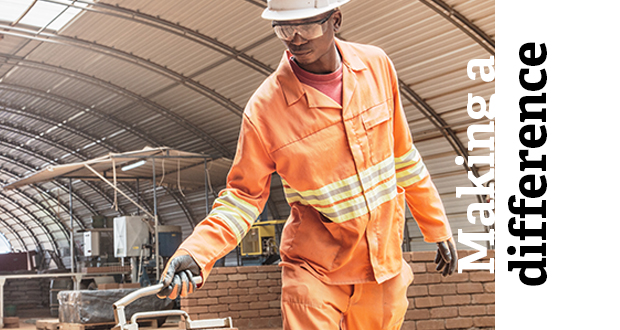Climate change: what DFIs can do to make a difference
Climate change is the most important challenge facing our generation. The scale of the challenge is vast. Last year, the Intergovernmental Panel on Climate Change’s special report underscored the importance of limiting temperature rises to 1.5°C for sustainable development and poverty eradication. The 1.5°C goal creates a clear pathway for global action – it means emissions need to be cut by 45 per cent by 2030 and reach net zero by 2050.
And it affects everything that CDC holds dear and is trying to accomplish – poverty alleviation, economic growth, and building a sustainable world. We know that the markets we invest in are already experiencing the effects of climate change. According to the World Bank, climate change has the power to push more than 100 million people back into poverty over the next 10 years. And it will hit communities in sub-Saharan Africa and Asia the hardest.
As well as being core to our development mission, climate change is increasingly being recognised as a major financial risk by the finance sector. Investors are concerned that an investment made today could be worth less than predicted in the future, either because an asset could be hit by an extreme weather event or because changes in technology or policy could prompt a reassessment of the value of a range of assets.
On the flip side, the opportunity is also huge. In 2018, the Global Commission on the Economy and Climate concluded that ambitious climate action does not need to cost much more than business-as-usual growth. Bold action on climate change could yield economic gains of $26 trillion and generate over 65 million new low-carbon jobs by 2030. The shift to clean growth is one of the most foreseeable and significant global economic trends and everyone – including governments, investors, businesses, civil society and individuals – has a role to play to support this economic transformation.
100 million
number of people at risk of being pushed back into poverty by climate change
What potential does a DFI have to make a difference?
The case is clear. Every country across the world must transition to a low-carbon economy in the next 30 years. At CDC, with a long history of investing in South Asia and Africa and the ability to deploy patient capital, we are well placed to support this. The key question as a DFI is: how can we not only manage climate-related risks and pursue climate opportunities as they arise, but more fundamentally, how can we support the poorest countries to deal with the economic transformation required to reach ‘net zero’, and in a way that is socially just?
We think any response has three parts: first, how can we help build the foundations of a carbon-free world given investment decisions today affect emissions tomorrow? Second, how can we support a ‘just transition’ to a low carbon economy by keeping job creation and skills development at the forefront of that change? And third, how can we strengthen the resilience of communities, businesses and people to the effects of climate change?
We’ve been committed to climate action for many years and have been implementing a climate policy for the last five years. The work we’ve been involved in already shows that consuming fewer resources and helping companies adapt to climate change helps to build sustainable businesses. At the same time, it benefits the communities these companies operate in and society as a whole.
What does this work look like?
Firstly, we know that there is significant potential for DFIs to use patient capital to support new cleaner technologies being deployed in developing markets. Investing in renewable energy is a key part of CDC’s current approach. In the last two years, we have committed over $500 million in clean power generation – 25 per cent of our annual commitments, up from 5 per cent in 2016. This has included founding the renewable energy platform Ayana to develop solar and wind generation projects across India. And it’s also meant investing in off-grid solar power company M-KOPA to provide 90 million hours of kerosene-free lighting a month, to 750,000 households across East Africa.
Secondly, we’ve been supporting the businesses we invest in – across sectors ranging from food and agriculture to construction and real estate to healthcare – to become climate smart. We’ve worked with Rainbow Hospitals, an Indian paediatric and maternity hospital chain, to both reduce resource use and utility bills at the same time. We supported Rainbow to gain ‘EDGE’ green-building certification for its Bangalore hospital, which has helped the hospital reduce its energy consumption by 27 per cent and its water use by 32 per cent as well as saving 1.5 million rupees.
Or there’s our work with Big Basket, India’s largest e-grocery company, which partners with more than 5,000 smallholders across 10,000 acres of farmland. With our support, Big Basket is piloting sustainable organic farms to be rolled out to 3,000 farmers over five years; and transitioning 2,500 delivery vehicles to electric, facilitating CO2 equivalent savings of 4,800 tonnes.
We also know that developing countries will feel the effects of climate change disproportionately, through increased weather events like droughts or cyclones. So we’ve been supporting companies to adapt and become more climate resilient. For example, we’ve worked with Jacoma Estates in Malawi to make its farms more climate resilient through an irrigation scheme for farms and surrounding smallholder farmers. And we’re working with Zephyr Power Limited, a renewable energy company in Pakistan, to implement a mangrove rehabilitation programme which will provide increased storm protection capacity along the coastline as well as to their wind farm.
Where next?
Nonetheless, we know that we need to go further if we’re going to meet the scale of the challenge that faces us. We also recognise that this is a rapidly changing field with private sector finance and climate policy moving quickly.
In July 2019, we signed up to the Task Force on Climate Related Financial Disclosures and will make disclosures in our accounts following the close of the financial year 2020-2021. Why is this so important? We know that ensuring climate-related risk is assessed and managed properly across the financial sector is vital in tackling climate change.
We’re currently working on a new climate change strategy and will share more about what this means for CDC early in 2020. As we’re developing this policy, we’re asking ourselves questions about the specific role that an institution like ours can play to support the goals of the Paris Agreement in the most effective way and as a complement to the work of others. Both the DFI community and the financial sector are rapidly stepping up their action on climate change, and we’re excited to play our part in building an inclusive, low-carbon, and resilient economy.
![]()
Nicola Mustetea, Climate Change Manager
Insight is our series of practical lessons on private sector investment and development, based on our experiences. Sign up to our monthly newsletter.








